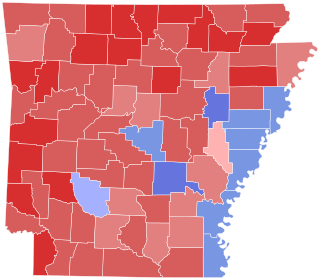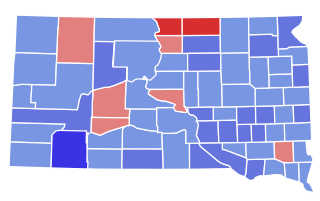
The 1978 United States Senate elections were held on November 7, in the middle of Democratic President Jimmy Carter's term. The 33 seats of Class 2 were contested in regular elections. Special elections were also held to fill vacancies.

The 1970 United States Senate elections was an election for the United States Senate. It took place on November 3, with the 33 seats of Class 1 contested in regular elections. Special elections were also held to fill vacancies. These races occurred in the middle of Richard Nixon's first term as president. The Democrats lost a net of three seats, while the Republicans and the Conservative Party of New York picked up one net seat each, and former Democrat Harry F. Byrd Jr. was re-elected as an independent.

The 1964 United States Senate elections were held on November 3. The 33 seats of Class 1 were contested in regular elections. Special elections were also held to fill vacancies. They coincided with the election of President Lyndon B. Johnson by an overwhelming majority, to a full term. His Democratic Party picked up a net two seats from the Republicans. As of 2023, this was the last time either party has had a two-thirds majority in the Senate, which allowed the Senate Democrats to override a veto, propose constitutional amendments, or convict and expel certain officials without any votes from Senate Republicans. However, internal divisions would have prevented the Democrats from having done so. The Senate election cycle coincided with Democratic gains in the House in the same year.

The 1914 United States Senate elections, with the ratification of the 17th Amendment in 1913, was the first time that all seats up for election were popularly elected instead of chosen by their state legislatures. And thus it became the first time that they were generally scheduled on Election Day to coincide with the U.S. House elections. The 32 seats of Class 3 were contested in regular elections in 1914. Special elections were also held to fill vacancies. These elections occurred in the middle of Democratic President Woodrow Wilson's first term.

The 1912–13 United States Senate elections were held on various dates in various states. They were the last U.S. Senate elections before the ratification of the Seventeenth Amendment in 1913, establishing direct elections for all Senate seats. Senators had been primarily chosen by state legislatures. Senators were elected over a wide range of time throughout 1912 and 1913, and a seat may have been filled months late or remained vacant due to legislative deadlock. Some states elected their senators directly even before passage of Seventeenth Amendment. Oregon pioneered direct election and experimented with different measures over several years until it succeeded in 1907. Soon after, Nebraska followed suit and laid the foundation for other states to adopt measures reflecting the people's will. By 1912, as many as 29 states elected senators either as nominees of their party's primary or in conjunction with a general election.

The 1996 United States Senate election in Minnesota was held on November 5, 1996. Incumbent Democrat Paul Wellstone won reelection to a second term defeating former Republican Senator Rudy Boschwitz in a rematch.

The 1998 United States Senate election in Arkansas was held on November 3, 1998. Incumbent Democratic Senator Dale Bumpers chose to retire instead of running for reelection to a fifth term. Making this was the first open seat with no incumbent held in this seat since the 1884 election. Democratic former U.S. Representative Blanche Lincoln won the open seat against Republican State Senator Fay Boozman. At 38, Lincoln was the youngest woman ever elected to the United States Senate. In 2010, Lincoln lost re-election to a third term by Fay Boozman's younger brother John Boozman.

The 1944 United States Senate election in North Dakota took place on November 7, 1944. Incumbent Republican Senator Gerald Nye ran for re-election to his fourth term. He faced a serious challenge to his renomination in the Republican primary, with prominent Fargo attorney Lynn Stambaugh and Congressman Usher L. Burdick running against him. He won with one-third of the vote, defeating Shambaugh, his closest opponent, by fewer than 1,000 votes. In the general election, Stambaugh continued his campaign against Nye as an independent, splitting the Republican vote as Governor John Moses, the Democratic nominee, ran a strong campaign. Though Nye had benefited from crowded general elections before, he bled Republican support to Stambaugh and Moses unseated him with just 45% of the vote. However, just a few months into Moses's term, he died in office, flipping the seat back to Republican control and triggering a June 1946 special election.

The 2016 United States Senate election in Arkansas was held November 8, 2016, to elect a member of the United States Senate to represent the State of Arkansas, concurrently with the 2016 U.S. presidential election, as well as other elections to the United States Senate in other states and elections to the United States House of Representatives and various state and local elections.

The 1934 United States Senate election in Minnesota took place on November 6, 1934. Incumbent Farmer–Labor U.S. Senator Henrik Shipstead defeated former State Senator Nathaniel J. Holmberg of the Republican Party of Minnesota and U.S. Representative Einar Hoidale of the Minnesota Democratic Party to win a third term.

The 1918 United States Senate election in Minnesota took place on November 5, 1918. It was the first election for Minnesota's Class 2 seat in the United States Senate, and the second U.S. Senate election in Minnesota overall, held after the ratification of the Seventeenth Amendment to the United States Constitution, which established the popular election of United States Senators. Incumbent U.S. Senator Knute Nelson of the Republican Party of Minnesota easily defeated his challenger in the general election, Willis Greenleaf Calderwood of the National Party, to win a fourth term in the Senate.

Two United States Senate elections were held in Illinois on March 26, 1913. The two elections were interconnected through a compromise made to elect a Democrat in the regular election and a Republican in the special election.

The 1914 United States Senate election in North Dakota took place on November 3, 1914. Incumbent Senator Asle Gronna, a Republican, sought re-election in his first popular election. Against several strong challengers, he won the Republican primary, though only with a plurality. In the general election, he faced former U.S. Senator William E. Purcell, the Democratic nominee. Gronna ultimately had little difficulty defeating Purcell to win re-election.

The 1922 United States Senate election in Minnesota took place on November 7, 1922. Farmer–Labor challenger Henrik Shipstead defeated incumbent Republican U.S. Senator Frank B. Kellogg and Democratic challenger Anna Dickie Olesen.

The 1923 United States Senate special election in Minnesota took place on July 16, 1923. The election was held to fill, for the remainder of the unexpired term, the seat in the United States Senate left vacant by Republican U.S. Senator Knute Nelson, who died in office on April 28, 1923. State Senator Magnus Johnson of the Farmer–Labor Party of Minnesota defeated Governor J. A. O. Preus of the Republican Party of Minnesota, and State Senator James A. Carley of the Minnesota Democratic Party, which, together with Henrik Shipstead's victory in 1922, brought both of Minnesota's seats in the United States Senate into the hands of the Farmer–Labor Party for the first time in history.

The 1924 United States Senate election in Minnesota took place on November 4, 1924. Republican U.S. Representative Thomas D. Schall defeated incumbent Farmer–Labor U.S. Senator Magnus Johnson and Democratic challenger John J. Farrell. Johnson, who was elected in the 1923 special election, had been in office for less than a year and a half when his attempt to win a full six-year term was defeated by Schall.

The 1930 United States Senate election in Minnesota was held on Tuesday November 4, Incumbent Senator Thomas D. Schal defeated Einar Hoidale of the Minnesota Democratic Party and Forner United States Representative Ernest Lundeen of the Farmer–Labor Party of Minnesota to win a second term.

The 1936 United States Senate special election in Minnesota took place on November 3, 1936. The election was held to fill the vacancy in the seat formerly held by Thomas D. Schall for the final two months of Schall's unexpired term. Governor Floyd B. Olson had appointed Elmer Benson to fill the seat in 1935, but this appointment was temporary and subject to a special election held in the next general election year thereafter—1936. Benson opted to run for governor instead of running for election to continue for the remainder of the term. No special primaries were held for the special election, and No special primaries were held for the special election, among Minnesota's three major parties, only the Republican Party of Minnesota officially fielded a candidate—Guy V. Howard. Regardless of the absence of Farmer-Labor and Democratic nominees, Howard nevertheless faced a great degree of competition from independent candidates Nathaniel J. Holmberg, Andrew Olaf Devold, and John G. Alexander.

The 1972 United States Senate election in South Dakota took place on November 7, 1972, concurrently with the U.S. presidential election as well as other elections to the United States Senate in other states as well as elections to the United States House of Representatives and various state and local elections.

The 1916 United States Senate election in New York was held on November 7, 1916. Incumbent Democratic Senator James O'Gorman chose not to seek re-election. Republican William M. Calder was elected to a succeed O'Gorman, defeating Democrat William F. McCombs.
























